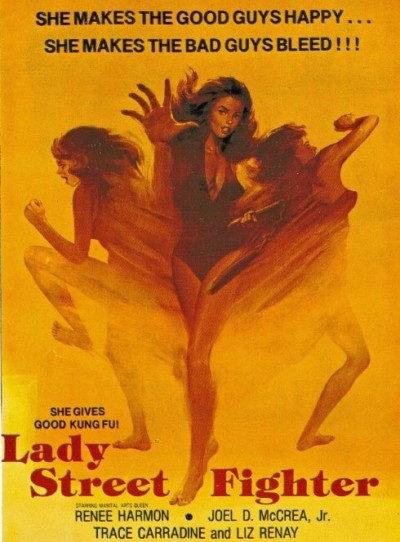★★★
“The Crow-ette”
 Zoe (Adrienne) is driving across country to meet her long-distance boyfriend, Dane (Samuel), when she has the misfortune to stumble into a pack of four rednecks, engaged in their favourite pastime of hunting the local Indians. When they stab one to death right in front of her, it’s clear things are going to end badly for her: and they do, as she is raped, brutalized and left near-dead in a shallow grave. But a conveniently-passing shaman finds her; though his efforts to save her are unsuccessful, the spirit of a dead chief enters Zoe. For, it turns out, he was killed by the ancestors of these same rednecks, and he sees in Zoe the chance to extract his long-awaited and brutal revenge. However, there’s a time-limit involved: since she’s still technically dead, decomposition is setting in…
Zoe (Adrienne) is driving across country to meet her long-distance boyfriend, Dane (Samuel), when she has the misfortune to stumble into a pack of four rednecks, engaged in their favourite pastime of hunting the local Indians. When they stab one to death right in front of her, it’s clear things are going to end badly for her: and they do, as she is raped, brutalized and left near-dead in a shallow grave. But a conveniently-passing shaman finds her; though his efforts to save her are unsuccessful, the spirit of a dead chief enters Zoe. For, it turns out, he was killed by the ancestors of these same rednecks, and he sees in Zoe the chance to extract his long-awaited and brutal revenge. However, there’s a time-limit involved: since she’s still technically dead, decomposition is setting in…
There are a couple of interesting wrinkles here, first that Zoe is deaf. This disability doesn’t play much part in proceedings, which is actually kinda cool: it’s just another aspect of her character. What is rather more relevant, is that Dane is black, so when he heads out in search of her, and crossed the path of the rednecks, it soon becomes very apparent that it isn’t just native Americans they dislike. All of which simply adds impetus to your enthusiasm for them to get their comeuppance, and that certainly happens. The “revenge” part of this rape-revenge flick starts with the possessed Zoe in a bar, yanking someone’s intestines out like they were tickets from an arcade game, and impressively, somehow manages to escalate from there. She gets to wield a variety of traditional weapons, such as a bow & arrow or spear, on the way to the slightly-less traditional tomahawk vs. chainsaw finale.
This only comes close to working if you don’t think about it too much: ideally, at all. Otherwise, you’ll be left wondering about questions like why the shaman didn’t do the sensible thing and call 911; too often, the supernatural aspects are used as an alternative for plot logic. Have to say, though, Adrienne is very good as Zoe, though in some ways, it’s a shame she has to be possessed by a male ghost to get her revenge. I’d have been perfectly happy for her to be intestine-yanking on her own terms, and Dane could also be excised from the plot entirely. Still, the further this heads into excess e.g. point-blank target practice, the more entertaining it is, and the practical effects are more than good enough to counter some distinctly ropey CGI work. As the title of this piece suggests, more than one review has compared this to The Crow – and that’s a reasonable parallel, considering its similar mix of soft-core spirituality and hard-core violence.
Dir: Michael S. Ojeda
Star: Amanda Adrienne, Tom Ardavany, Ronnie Gene Blevins, Marc Anthony Samuel























 Let me start off by repeating myself, in case you missed it, because I want to be absolutely clear on these points. This is legitimately terrible. This is among the worst films I’ve ever seen. And I speak as someone with over 25 years of watching really bad films. That half-star is solely for amusement to be gathered from how bad this is, because there are basically no redeeming features here at all, and I speak as someone who will tolerate almost any pile of shit with an action heroine in it. This movie is largely responsible for the addition of the word “almost” to the previous sentence, despite being mercifully brief at a mere 72 minutes in length. The half-star is simply because I did reach the end without gnawing a limb off to escape. I think I deserve some kind of Internet prize for that.
Let me start off by repeating myself, in case you missed it, because I want to be absolutely clear on these points. This is legitimately terrible. This is among the worst films I’ve ever seen. And I speak as someone with over 25 years of watching really bad films. That half-star is solely for amusement to be gathered from how bad this is, because there are basically no redeeming features here at all, and I speak as someone who will tolerate almost any pile of shit with an action heroine in it. This movie is largely responsible for the addition of the word “almost” to the previous sentence, despite being mercifully brief at a mere 72 minutes in length. The half-star is simply because I did reach the end without gnawing a limb off to escape. I think I deserve some kind of Internet prize for that. This film’s origins as a stage play are painfully apparent, and you can also see why the distributor’s felt it needed to have 45 minutes cut out before it could be released, as frankly, it’s a bit of a bore. The battle to recapture Orleans is the only action of note here, even though that represented the start of the Maid’s campaign to restore France to its proper ruler (Ferrer), rather than the end. After that, this more or less skips forward to his coronation, then Joan’s capture, spending the rest of the movie – and there’s a lot of it – going through the trial, and the railroading of the heroine into, first throwing herself on the church’s mercy, then recanting her recantation and returning to wearing men’s clothes, thereby sealing her fate. There’s not much here which you won’t have seen before, if you’ve seen any of the other versions of the story, touching the usual bases from Joan’s revelations that she’s going to be the saviour of France, through her trip to see the Dauphin, and so on. It does downplay the “voices” aspect, especially early on, perhaps a wise move since it’s difficult to depict, without making her seem like a religious fruitcake.
This film’s origins as a stage play are painfully apparent, and you can also see why the distributor’s felt it needed to have 45 minutes cut out before it could be released, as frankly, it’s a bit of a bore. The battle to recapture Orleans is the only action of note here, even though that represented the start of the Maid’s campaign to restore France to its proper ruler (Ferrer), rather than the end. After that, this more or less skips forward to his coronation, then Joan’s capture, spending the rest of the movie – and there’s a lot of it – going through the trial, and the railroading of the heroine into, first throwing herself on the church’s mercy, then recanting her recantation and returning to wearing men’s clothes, thereby sealing her fate. There’s not much here which you won’t have seen before, if you’ve seen any of the other versions of the story, touching the usual bases from Joan’s revelations that she’s going to be the saviour of France, through her trip to see the Dauphin, and so on. It does downplay the “voices” aspect, especially early on, perhaps a wise move since it’s difficult to depict, without making her seem like a religious fruitcake.